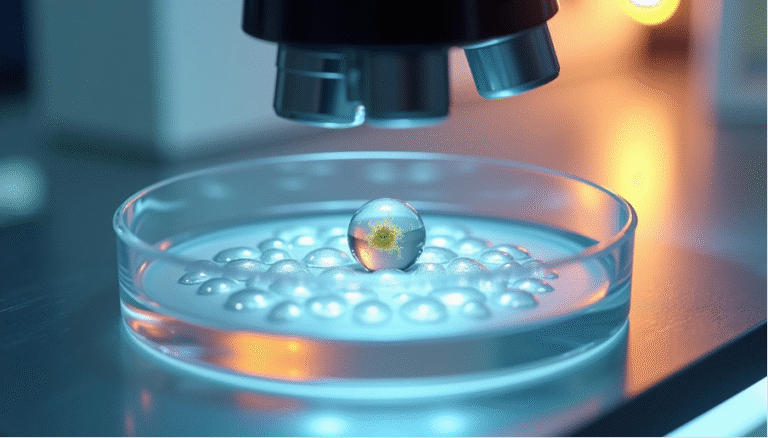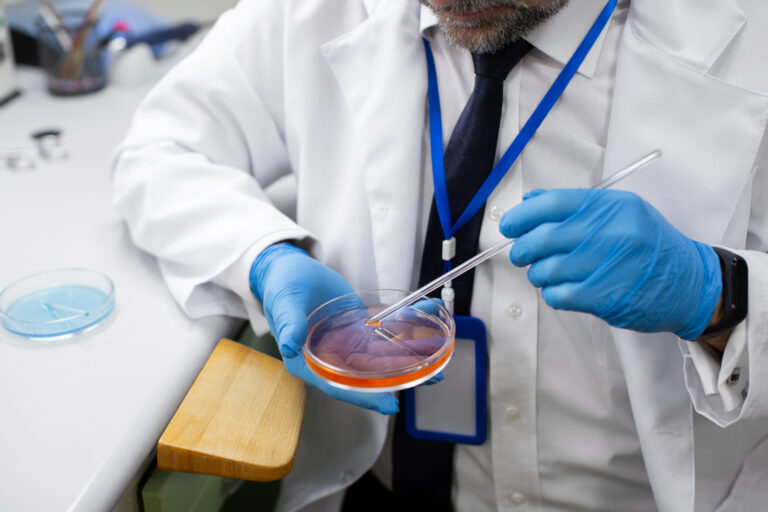Spotting after embryo transfer often causes immediate worry during your IVF trip. Statistics show that 40% of women who conceive through IVF notice some bleeding or spotting after their transfer procedure. Understanding this common occurrence can help ease your anxiety instead of assuming something is wrong.
Small spots or streaks that last a day or two typically characterise post-embryo transfer spotting. About one-fourth of all pregnancies show some vaginal bleeding in the first trimester. IVF pregnancies see this more frequently. Knowing the difference between normal implantation spotting and concerning bleeding is vital to your peace of mind and health. This piece will show you which spotting signs are positive and when you should call your doctor.
Understanding Spotting After Embryo Transfer
Spotting shows up as small spots or streaks of pink, brown, or light red discharge. Regular bleeding looks quite different. Spotting is substantially lighter – you might notice it only while wiping or as tiny stains on your underwear. This difference is vital because the type, colour, and volume of discharge can indicate various things during your IVF experience.
What is spotting and how it is different from bleeding
Spotting is fundamentally different from bleeding. True bleeding appears heavier with bright or dark red flow that needs a pad. The colour of spotting tends to be light pink or brownish. It comes and goes without soaking through a pad. Regular bleeding lasts 3-7 days, while spotting usually continues for 1-3 days. Understanding these differences helps you interpret your body’s signals better.
Common timing: spotting after embryo transfer day 1 to day 10
Your spotting’s timing after embryo transfer can reveal its cause. Some women spot right after the transfer if their doctor faced technical challenges or needed to adjust the cervix. Spotting often shows up 6-12 days after transfer, which matches the implantation window. Research shows approximately 15-25% of women experience spotting during this significant implantation period.

How spotting relates to implantation
The embryo’s attachment to the uterine lining causes implantation bleeding. Small blood vessels get disrupted during this process, which happens 7-10 days after your embryo transfer. All the same, not every successful implantation leads to spotting – many women get pregnant without seeing this sign at all. IVF treatment often includes progesterone supplements that can make uterine blood vessels more delicate, leading to spotting. On top of that, vaginal suppositories used to prepare your uterus might make your cervix sensitive and cause light bleeding, especially after intercourse.
Also Read: When to Go for IVF Treatment: Your Step-by-Step Decision Guide
Signs That Spotting May Be a Positive Indicator
Spotting can worry you at first, but certain signs actually point to a successful embryo implantation. These positive signs help you tell the difference between concerning bleeding and promising developments in your IVF trip.
Implantation bleeding: pink or brown spotting
The colour of your spotting provides important signs about its cause. Implantation bleeding shows up as light pink or brownish discharge, different from the bright red blood you see during menstruation. The blood has time to oxidise before leaving your body, which creates these pinkish or rusty brown shades. The timing is crucial implantation bleeding usually happens between 7-10 days after your embryo transfer. This matches exactly when the embryo attaches to your uterine lining. This light spotting is one of the earliest signs that your embryo has successfully implanted.
Mild cramping and breast tenderness
You might feel mild cramping as the embryo embeds into your uterine wall. These feelings are not as intense as regular menstrual cramps—they feel more like a light pulling or tingling in your lower abdomen. Your breasts might become tender with these symptoms. They could feel unusually sore, swollen or sensitive to touch. These changes happen because of hormonal shifts that start right after successful implantation. The tenderness feels stronger than what you normally experience before your period.
Spotting without pain or heavy flow
Positive implantation bleeding stays light and manageable. The spotting:
- Looks much lighter than your period usually just a few drops
- Doesn’t need frequent pad changes
- Lasts only 1-3 days
- Stops by itself
Research shows about 40% of women who conceive through IVF see some bleeding or spotting after transfer. This spotting doesn’t guarantee pregnancy since progesterone supplements can cause it too. But when it comes with mild cramping and breast tenderness, it often means successful implantation.
When Spotting Could Be a Warning Sign
Some spotting after transfer is normal, but you should watch for specific warning signs that need immediate medical attention. Here’s what to look for:
Heavy bleeding or bright red discharge
You need medical help if the bleeding soaks through a pad within an hour or looks bright red. This is different from the light pink or brown spotting you might see during implantation. Heavy, bright red bleeding could mean there’s a problem that needs quick evaluation.
Severe cramps or lower back pain
Mild discomfort is different from intense pain. Sharp abdominal cramps or severe lower back pain could point to an ectopic pregnancy or other complications. Yes, it is crucial to get urgent medical care as these symptoms might show that the embryo has attached outside the uterus.
Spotting lasting more than 3 days
Implantation bleeding usually stops within 1-3 days. Any spotting that goes beyond this time without slowing down needs a doctor’s evaluation.
Associated symptoms: nausea, vomiting, dizziness
Watch out for these warning signs:
- Dizziness or fainting
- Nausea and persistent vomiting
- Fever or chills
- Blood clots
We noticed that these symptoms, especially when they come with bleeding, could point to serious issues like miscarriage, ectopic pregnancy, or infection. Call your fertility specialist right away if you notice any of these concerning symptoms along with spotting.
Also Read: Early IVF Pregnancy Test: When Is the Perfect Time to Check?
What to Do If You Experience Spotting
Specific actions can help your physical and emotional wellbeing if you notice spotting after your embryo transfer.
Track the colour, amount, and duration
Your medical team needs detailed information about any spotting you experience. Keep track of its colour (pink, brown, or red), the amount, and how long it continues. These details are a great way to get clear communication with your healthcare providers.
Avoid strenuous activity and intercourse
Rest should be your priority right now. Stay away from heavy lifting and sexual activity until your doctor gives you the green light. These simple precautions can reduce bleeding and protect the implantation process.
When to call your doctor
Reach out to your fertility specialist right away if you notice:
- Bright red or heavy bleeding
- Severe abdominal cramps
- Blood clots
- Dizziness or fainting
- Fever or unusual symptoms
Any bleeding with severe pain or bleeding that lasts longer than expected needs immediate medical attention. Your doctor wants to hear about changes that worry you – you understand your body best.
Emotional support and managing anxiety
Anxiety management plays a key role during this uncertain time. You might want to:
- Talk about your feelings with your partner or friends
- Connect with other IVF patients
- Seek support from a counsellor
Spotting can trigger worry after investing so much in your IVF experience. Your emotional reactions make perfect sense.
Conclusion
Seeing spots after an embryo transfer can cause anxiety during your IVF trip. All the same, you can reduce your stress by knowing the difference between normal implantation bleeding and concerning symptoms. Light pink or brown spotting between days 7-10 after transfer often points to successful implantation. This kind of spotting stays light and goes away within 1-3 days on its own.
Bright red bleeding, bad cramps, or symptoms that last more than three days need immediate medical attention. Your doctor needs to know the colour, amount, and how long the spotting lasts. About 40% of women see some form of spotting after embryo transfer, but everyone’s body reacts differently to the procedure.
Taking it easy is vital during this waiting time. It also helps to lean on partners, friends, or counsellors to handle the worry that comes with waiting. Trust your gut—you know your body best, so don’t think twice about calling your doctor if something doesn’t feel right.
The two-week wait after embryo transfer tests anyone’s patience. Looking at spotting with knowledge instead of fear helps you spot both good signs and warning signals. You can now direct yourself through this key phase of your fertility trip with more confidence, whether the spotting means successful implantation or needs medical attention.
Key Takeaways
Understanding spotting after embryo transfer can help distinguish between normal implantation signs and concerning symptoms that require medical attention.
- Light pink or brown spotting 7-10 days post-transfer often indicates successful implantation and affects 40% of IVF patients.
- Bright red bleeding, severe cramps, or spotting lasting over 3 days requires immediate medical consultation.
- Track spotting colour, duration, and amount whilst avoiding strenuous activity and intercourse during recovery.
- Mild cramping with breast tenderness alongside light spotting typically signals positive embryo implantation.
- Contact your fertility specialist immediately if experiencing dizziness, fever, blood clots, or heavy bleeding
Remember that your body’s response to embryo transfer is unique, and trusting your instincts about concerning changes is crucial for both your physical health and emotional wellbeing during this critical waiting period.
FAQs
Q1. What are the early signs of successful embryo implantation after IVF? Early signs may include light pink or brown spotting 7-10 days after transfer, mild cramping, and breast tenderness. However, not all women experience these symptoms, and their absence doesn’t necessarily indicate failure.
Q2. Is spotting after embryo transfer always a positive sign? Not always. While light spotting can indicate successful implantation, heavy bleeding or bright red discharge may be concerning. It’s important to monitor the colour, amount, and duration of any bleeding and consult your doctor if you’re worried.
Q3. How long does implantation bleeding typically last? Implantation bleeding usually lasts 1-3 days. If spotting continues beyond this timeframe or becomes heavier, it’s advisable to contact your fertility specialist for guidance.
Q4. Can you have a successful pregnancy without experiencing implantation bleeding? Yes, absolutely. Many women achieve successful pregnancies without experiencing any spotting or bleeding. The absence of implantation bleeding doesn’t indicate failure of the IVF process.
Q5. When should I contact my doctor about spotting after embryo transfer? You should contact your doctor immediately if you experience heavy bleeding, severe cramps, blood clots, dizziness, fever, or if spotting lasts more than 3 days. It’s always better to err on the side of caution and seek medical advice if you’re concerned.
Disclaimer: This article is for informational purposes only and does not constitute medical advice. Always consult with a qualified healthcare provider for personalized guidance regarding fertility treatments




